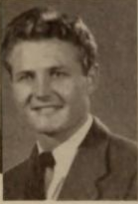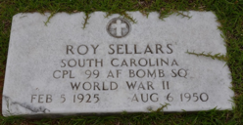Scroll of Honor – Roy Sellars
Cold War Heats Up
Written by: Kelly Durham
The start of the Korean War in June 1950 caught the United States by surprise. American forces were quickly pushed south, retreating to the “Pusan Perimeter,” the extreme southeastern corner of the Korean Peninsula. From there, South Korean and American troops held out desperately while they awaited reinforcements.
retreating to the “Pusan Perimeter,” the extreme southeastern corner of the Korean Peninsula. From there, South Korean and American troops held out desperately while they awaited reinforcements.
In Washington, President Truman, fearing that Taiwan or even Japan might be the next objective of the Communist invaders, made the grave decision to transfer nuclear weapons from the United States to the Pacific island of Guam, that much closer to the battlefront.
Roy Sellars of Gaffney was an Air Force corporal. He had attended Clemson for two years, from 1947 to 1949, and had been a member of the Cherokee County Club. On August 5, 1950 he was assigned as the tail gunner of an Air Force B-29 Superfortress about to embark on a top-secret mission to transport a Mark 4 atomic bomb to Guam. The core for the bomb would be flown separately.
The pilot for the mission was Air Force Captain Eugene Steffes. Flying in the copilot seat and acting as mission command pilot was Brigadier General Robert Travis, a veteran of thirty-five combat missions over Nazi-occupied Europe during the previous war. At 2200 Pacific Standard Time the B-29 with its ominous cargo was cleared for takeoff from runway 21 Left at Fairfield-Suisun Air Force Base near Sacramento, California. Just prior to liftoff, the B-29’s number 2 engine malfunctioned. Steffes ordered the propeller feathered and attempted to raise the landing gear to reduce drag and get the plane safely into the air, but the gear would not retract.
Faced with rising terrain ahead, Steffes rolled the lumbering aircraft into a 180-degree turn hoping to make it back for a landing at the base. According to the Air Force accident report, “Upon completion of the turn, the left wing became difficult to hold up.” Steffes allowed the aircraft to slide to the left to avoid crashing into a trailer park, but by now the plane was only a few feet above the ground and a crash was imminent. The B-29 hit the ground at a speed of approximately 120 miles per hour and slid through a field, caught on fire, and broke into pieces. The impact had warped the airframe such that some escape hatches were jammed and unusable. The ten crew and passengers in the rear compartment of the big bomber suffered fatal injuries.
Paul Ramoneda, a sergeant assigned to the Ninth Food Service Squadron, was one of the first to reach the aircraft. He pulled Steffes from the cockpit. Alerted by the noise of the crash, airmen and civilians converged on the accident scene to assist. Flares and .50 caliber ammunition began to ignite in the burning wreckage making the scene even more hazardous. Despite orders from the squadron commander to get away from the plane and let it burn, Ramoneda wrapped his baker’s apron around his head for protection and returned to the burning aircraft to search for more survivors. At about that time, some twenty minutes after the crash, the high explosives contained in the Mark 4 detonated. Ramoneda and five firefighters were killed. General Travis was found nearby on the ground.
In addition to those killed in the crash, Sellars among them, the explosion claimed seven more lives while wounding 180 others, forty-nine of whom required hospitalization. Travis too died from his injuries. Fairfield-Suisun Air Force Base was renamed Travis Air Force Base in his memory.
Corporal Roy Sellars was survived by his parents, Mr. and Mrs. William H. Sellars of Gaffney.  He is buried at Gaffney’s Oakland Cemetery.
He is buried at Gaffney’s Oakland Cemetery.
For more information about Roy Sellars see:
http://soh.alumni.clemson.edu/scroll/roy-sellars/
For additional information on Clemson University’s Scroll of Honor visit:
http://soh.alumni.clemson.edu/
Crash site photo: http://www.check-six.com/images/Crash_Sites_images/Travis-B-29/Crash_Site_Panarama-lg1.jpg
See also Command and Control, Eric Schlosser, Penguin Books, New York, NY, 2013

